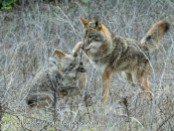- looking around
- dozing
- watching mostly dogs
Most coyote activity usually begins after dark, but sometimes some family members are ready to begin their evening activities well before then. Yesterday, by late afternoon I found this young, almost-two-year-old female lying down in a field in the shadow of some bushes. She was very well concealed, but visible if you actually knew what you were looking for. She kept her eye on the passers-by in the distance, keeping her focus mostly on unleashed active dogs running energetically all over the place, but none came in her direction. Soon, grooming herself became her focus of activity –the bugs were bugging her!
- grooming
- bugs!
- grooming
She began getting up to better reach some of the irritating rascals on her body, then she lay back down. After several of these getting-up and then lying-down again cycles, she sat up, stretched, and slowly began to wander off.
- “Boring. . .”
- stretching while sitting
- stretching
She probably had been waiting there for the rest of her family. It’s a place they have met up frequently before heading out together in the evening, but today she was probably tired of waiting and decided to jump-start her activities. Even coyotes can get bored!

leaping after a sound she heard, but coming up empty handed
She walked calmly along, following the line of the bushes, and stopped sporadically at whatever movements caught her eye. A couple of times she bounced fast and high over tall grasses, a little like a jackrabbit, towards something that caught her interest, but the prospective meal never panned out. So she continued on.

She stops to listen
Everything seemed quiet when she suddenly stopped, turned around, and looked into the distance. She listened intently, and then she began calling out. In between her calling out, during the silences, far, far into the distance, I could barely hear two other coyotes calling out (you will also hear a couple of domestic dogs barking). Our young female was responding. This video covers her responding. Her sporadic vocalizations went on for a couple of minutes (this video is the entirety of it) even after the others had ceased their end of the communication. When she was through, she trotted off in their direction. They would meet and greet, as I’ve seen them so often do, and then head out together on their evening trekking expedition, sticking together for a while as a family, splitting apart at time, and then coming together throughout the evening and until dawn.
Each coyote’s voice and pattern of sounds is identifiable and distinguishable by the other coyotes — not dissimilar to the way you recognize voices over the telephone. I myself am able to identify some of the coyotes by their vocalizations.









































 When I think of coyote footprints in the winter, I think of those left in crisp white snow. But we don’t have snow here in San Francisco (though we did 20 years ago: we all went out to take photos of it to use in our Season’s Greetings cards!). Their footprints can also be seen in mud. Wet footprints on pavement work just as well, as you can see here. These are one coyote’s footprints, though there were two coyotes trotting alongside each other at a hard-to-keep-up-with pace — they had direction and purpose to their gait, without seeming to actually hurry. I tried catching up but didn’t. They began their trot after howling first in response to each other — probably locating one another — and then continuing their howling in response to sirens (listen below). That’s how I knew where they were. They slithered by quickly, trying not to draw attention and were pretty successful — I just happened to be keeping my eye open for them after I heard them. I tried to record the quick glimpse I got of them (did a tree fall in the forest if none saw it?) — I caught only a blur of them scurrying over the meadow. They were already far and away by the time I reached the pavement where I last saw them.
When I think of coyote footprints in the winter, I think of those left in crisp white snow. But we don’t have snow here in San Francisco (though we did 20 years ago: we all went out to take photos of it to use in our Season’s Greetings cards!). Their footprints can also be seen in mud. Wet footprints on pavement work just as well, as you can see here. These are one coyote’s footprints, though there were two coyotes trotting alongside each other at a hard-to-keep-up-with pace — they had direction and purpose to their gait, without seeming to actually hurry. I tried catching up but didn’t. They began their trot after howling first in response to each other — probably locating one another — and then continuing their howling in response to sirens (listen below). That’s how I knew where they were. They slithered by quickly, trying not to draw attention and were pretty successful — I just happened to be keeping my eye open for them after I heard them. I tried to record the quick glimpse I got of them (did a tree fall in the forest if none saw it?) — I caught only a blur of them scurrying over the meadow. They were already far and away by the time I reached the pavement where I last saw them.
